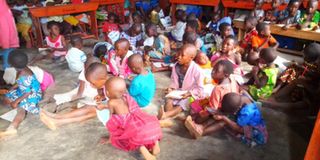Prime
Lives at risk in Kasese’s dilapidated structures

Pupils of Primary One at Kisabu Primary School in Kasese District during a lesson on March 23, 2023. PHOTO | MOUREEN BIIRA
What you need to know:
- To make worse, in 2020, the school was hit by floods that destroyed some of its structures, leaving it in a sorry state.
Some schools in Kasese District have continued operating in dilapidated structures, putting the lives of pupils at risk.
Many of these schools were founded by the Church and taken over by the government.
For instance, Harukungu Primary School in Isango Sub-county in Bukonzo West County has two classrooms that house an office and a class.
The School headteacher, Mr John Baluku, said since the school was founded by the South Rwenzori Diocese, most of the classes are conducted at All Saints Harukungu Church due to inadequate space.
“Primary One, Two and Three conduct their lessons from the church since the school is located on the church compound,” said Mr Baluku.
He, however said, the school conducts lessons for three different classes under one roof.
“Pupils therefore lose concentration.”
The school has 434 pupils in total from Primary One to Primary Seven.
He said in case the church has other functions, the lessons are suspended or some pupils are taken to study under trees.
“The school has one latrine with eightstances which we share with teachers and because we don’t use padlocks, we find ourselves fighting for space, especially after lunch hours. But others ease themselves in the bush,” Melvin Asimawe, a Primary Six pupil said.
At Kisabu Primary school in Kitholhu Sub-county, the school has dilapidated semi-permanent structures.
There is also understaffing that is contributing to the learners’ underperformance, according to teachers and parents.
To make worse, in 2020, the school was hit by floods that destroyed some of its structures, leaving it in a sorry state.
Mr Josephat Muhindo Kamukade, the headteacher, said they have 315 pupils with one permanent classroom block that accommodates two classes and the office of the head teacher.
“We appreciate Save the Children (a Non-governmental organisation) that provided us with tarpaulins to put up makeshift classrooms. But they are now worn out and in a sorry state to accommodate pupils,” he said.
At St John’s Kamasasa Primary school in Karambi Sub-county, pupils study in dusty classes, exposing learners to jiggers.
The community school has more than 300 pupils, a permanent classroom block with five rooms and a semi-permanent classroom block.
Stakeholders cry out
Mr Timothy Musa, a parent, said the government should take up the school for better management and support and should also build more schools and equip existing ones with facilities.
Another community school, King Adams Model Nursery and Primary School, is also in a sorry state.
The school, which has classes up to Primary Five, has more than 100 pupils studying in partially grass-thatched classes, whereby during the rainy season, the roofs leak.
Ms Gloria Kabugho, a teacher at the school, said the learning environment is also not conducive especially during the rainy season when the school compound floods.
“When it rains, no child turns up for classes because of the mud in and outside the classrooms. The few who come study while standing,” She said.
Other primary schools with inadequate infrastructure include Nyidango, Kithobira, Kalingwe, Muyina, Buzira, Bughema and Kasingiri.
The South Rwenzori Diocesan Education Coordinator, Rev Asa Masereka Kiriaghe, said there is a need for the government to refurbish most of the schools which it took over from the Church because they are in appalling condition.
He said: “Most of our schools lack staff quarters and the classrooms are even few compared to the overwhelming numbers of pupils. Most teachers who cannot afford to rent near the schools walk long distances and this affects their performance as well as the teaching process.”
The Kasese District Chairman, Mr Eliphaz Muhindi Bukombi, said interventions will be done gradually due to limited resources.
“We are planning to construct more classrooms in our schools. But we may not be able to do it at once as a local government,” he said.




